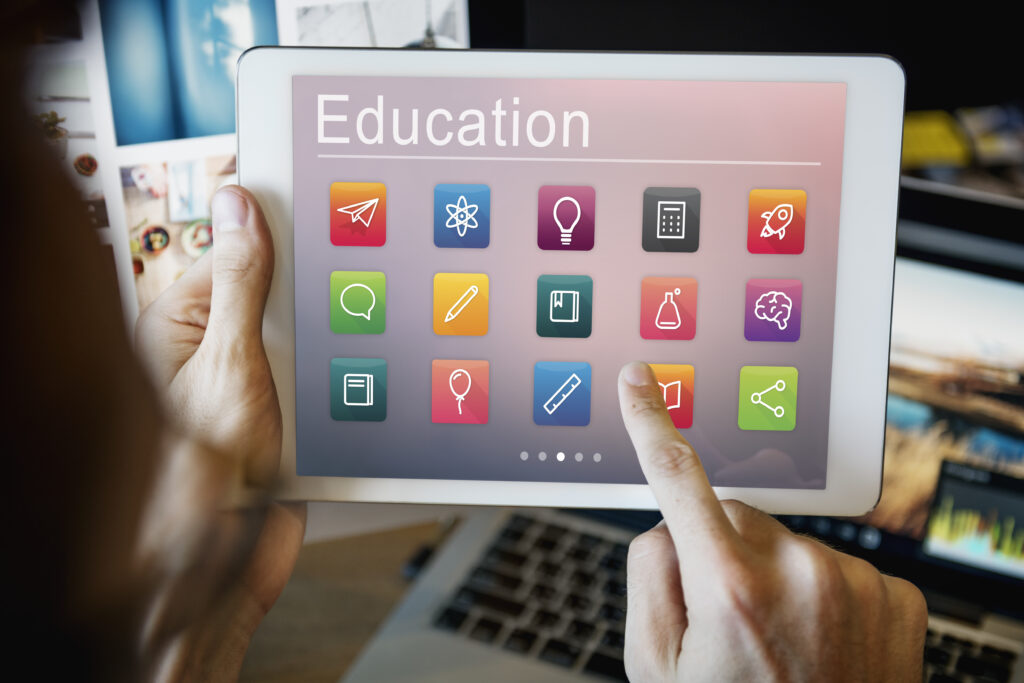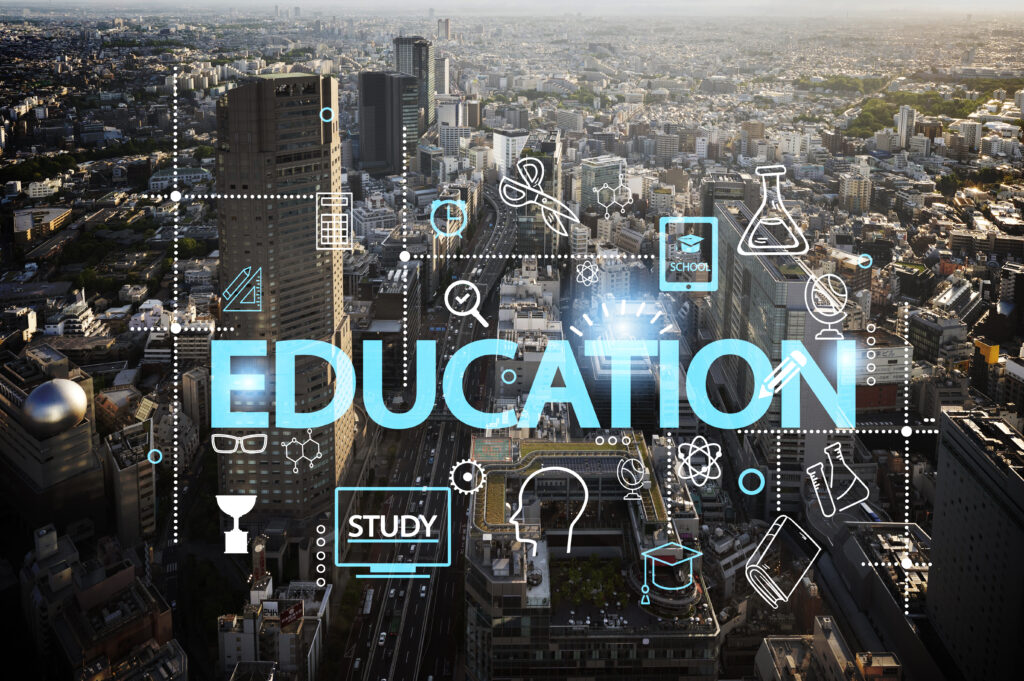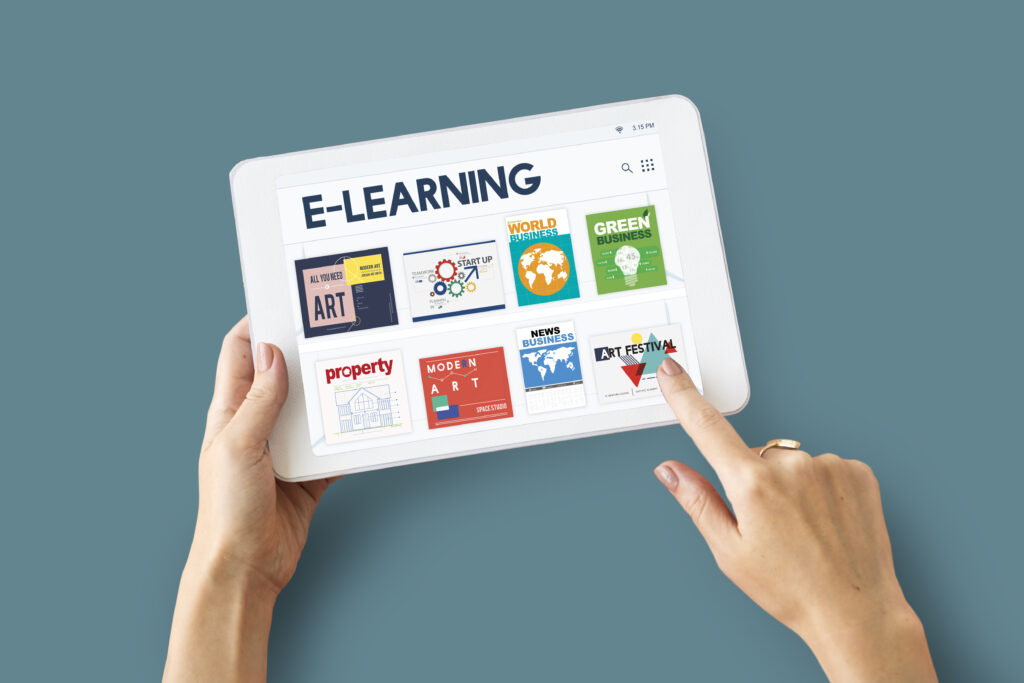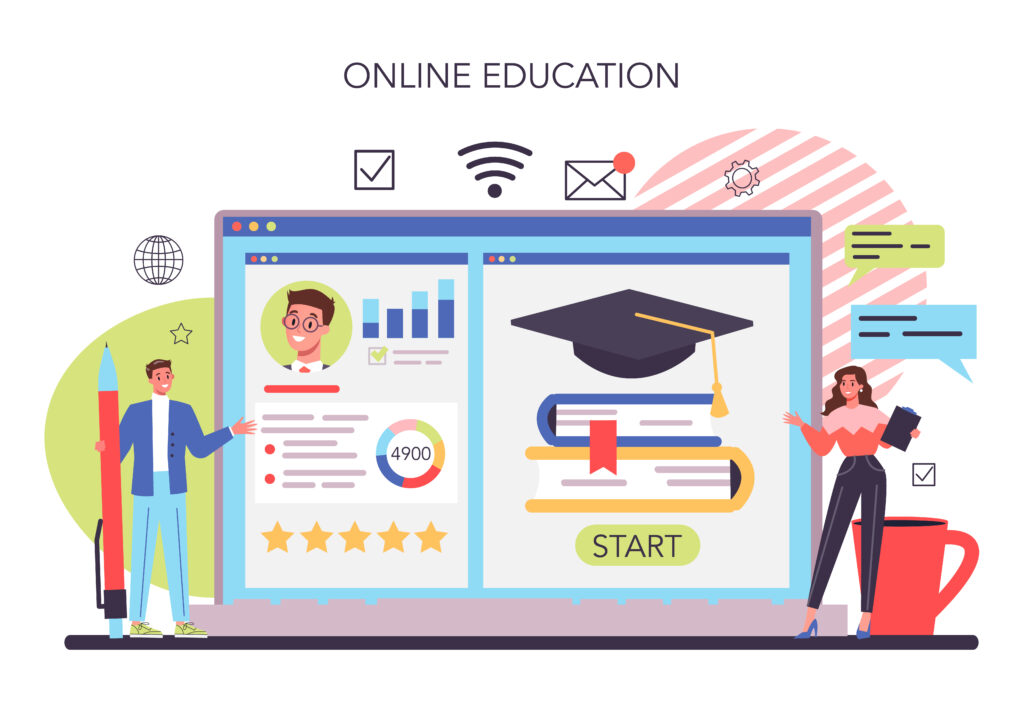Introduction:
E-Learning Platform, In the rapidly evolving landscape of education, the advent of e-learning has ushered in a transformative era, redefining how knowledge is acquired and disseminated. E-learning, short for e-learning platform, encapsulates a broad spectrum of educational activities conducted via digital technologies, ranging from online courses and virtual classrooms to interactive multimedia modules. It represents a departure from traditional educational models, harnessing the power of digital technology to create flexible, accessible, and dynamic learning experiences.

The transformative impact of e-learning platform is intricately tied to the pervasive influence of digital technology on the educational landscape. As we navigate through the 21st century, where technology is deeply ingrained in our daily lives, the realm of education has undergone a profound shift. The traditional confines of brick-and-mortar classrooms are expanding into the boundless realm of cyberspace, propelled by the democratization of information through the internet, the proliferation of smart devices, and the innovation of interactive learning platforms.
In today’s fast-paced, tech-driven world, exploring the realm of e-learning is not merely an option but a necessity. The rapid acceleration of information, coupled with the demand for continuous skill development, requires a flexible and accessible approach to education. E-learning emerges as a solution that transcends geographical barriers, offering learners the freedom to engage with educational content on their terms, at their pace, and from virtually anywhere in the world.
The importance of delving into the realm of e-learning becomes even more pronounced as we witness the convergence of global connectivity and the need for lifelong learning. This digital revolution in education not only caters to the needs of traditional students but also extends its reach to professionals seeking to upskill, career changers navigating new industries, and learners from diverse backgrounds hungry for knowledge.
I. The Evolution of E-Learning: Navigating the Educational Time Machine
E-Learning Platform, Embarking on a journey through the annals of educational history, the evolution of e-learning unveils itself as a captivating odyssey, akin to navigating an educational time machine. This exploration takes us through the transformative phases that have shaped e-learning into the dynamic and accessible educational realm we know today.

1.1 Historical Context: Tracing E-Learning’s Roots
E-Learning Platform Embarking on an insightful journey into the historical origins of e-learning unveils a narrative that transcends traditional educational paradigms. Tracing its roots requires delving into the genesis of distance learning, where correspondence courses laid the foundation for a revolutionary evolution. From the humble beginnings of mailing assignments, the landscape gradually transformed, paving the way for the emergence of e-learning.
As we unravel the historical context, it becomes evident that e-learning’s evolution is intertwined with the pursuit of overcoming geographical barriers. The transition from traditional distance learning to the current digital era reflects a relentless quest for innovative educational models. The amalgamation of technology and pedagogy has transformed the solitary endeavor of learning into a dynamic, interactive, and globally accessible experience.
1.2 Technological Advancements: Shaping the Digital Classroom
A panoramic overview of the technological advancements steering the e-learning revolution reveals a landscape sculpted by the forces of the internet, multimedia, and interactive tools. The internet, a linchpin in this transformation, acts as a connective tissue, seamlessly linking learners to a vast repository of knowledge. It serves as the digital highway, facilitating the exchange of information, resources, and collaborative learning experiences.
Multimedia, a multifaceted gem in the e-learning crown, takes center stage in enhancing engagement and comprehension. From video lectures that transcend the constraints of physical presence to interactive presentations that transform passive learning into an immersive journey, multimedia catalyzes a paradigm shift in educational delivery.
Interactive tools, the architects of engagement, empower learners to actively participate in their educational voyage. From virtual simulations that bring theoretical concepts to life to collaborative platforms that foster peer-to-peer interaction, these tools redefine the dynamics of the digital classroom.
II. Key Components of E-Learning: Unveiling the Digital Arsenal
In the dynamic landscape of education E-Learning Platform, the key components of e-learning stand as the pillars that uphold a transformative and engaging learning experience. This digital arsenal encompasses a diverse array of tools and methodologies designed to revolutionize the way we acquire and process knowledge. Let’s delve into the core components that form the backbone of e-learning:

2.1 Digital Content Delivery: A Symphony of Learning Modalities
Embarking on the exploration of e-learning’s core components, the realm of digital content delivery unfolds as a diverse landscape. Video lectures, the visual tapestry of knowledge, transcend traditional constraints, bringing experts and learners into a shared virtual space. E-books, the digital tomes of academia, offer portability and accessibility, reshaping the way information is consumed. Interactive presentations, a dynamic blend of multimedia, engage learners actively, transforming passive absorption into an immersive experience. In this digital symphony, the impact of multimedia emerges as a catalyst, enhancing engagement and elevating learning outcomes to new heights.
2.2 Learning Management Systems (LMS): Orchestrating Educational Excellence
The introduction to online platforms and Learning Management Systems (LMS) marks a pivotal moment in the e-learning narrative. LMS becomes the digital hub, seamlessly connecting instructors and learners, transcending physical boundaries. This centralized platform not only facilitates course management but becomes the epicenter for assessments, fostering interaction, and creating a collaborative educational ecosystem. It is the technological backbone that propels the digital classroom forward, ensuring a streamlined and effective educational experience.
2.3 Flexibility and Accessibility: Beyond Temporal and Spatial Constraints
As we delve into the intricacies of e-learning, the examination of flexibility and accessibility becomes paramount. E-learning shatters the shackles of time and location, offering learners the freedom to tailor their educational journey according to individual schedules and commitments. The breaking down of geographical barriers becomes a testament to the democratization of education, ensuring that knowledge is not confined to a particular region but is accessible globally.
III. The Benefits of E-Learning: A Digital Dividend
Embracing e-learning ushers in a realm of transformative benefits, collectively forming a digital dividend that enriches the educational landscape. As we navigate this digital odyssey, let’s unveil the numerous advantages that learners, educators, and institutions reap from the dynamic world of e-learning:

3.1 Accessibility: Bridging Geographical Gaps
The digital landscape of e-learning serves as a bridge, overcoming geographical constraints that have historically hindered educational opportunities. It emerges as a powerful tool for enabling education for diverse demographics, making quality learning experiences accessible to learners regardless of their physical location.
3.2 Flexibility: Empowering Learners on Their Terms
Flexibility, a hallmark of e-learning, becomes a dynamic force accommodating the myriad schedules and commitments of learners. This adaptability empowers individuals to chart their educational journey at their own pace, fostering a personalized and effective learning experience.
3.3 Cost-Effectiveness: Navigating Financial Frontiers
The financial dimension of e-learning surfaces as a cost-effective alternative, reducing the economic burdens on both institutions and learners. Sustainability becomes a key aspect of digital education, with the reduction of physical infrastructure and printed materials aligning with eco-friendly practices.
IV. Challenges and Considerations: Navigating the Digital Seas
As we sail through the vast expanse of e-learning, it’s crucial to recognize the challenges and considerations that accompany this digital voyage. Navigating the digital seas of education brings forth a set of intricacies that demand attention and thoughtful strategies. Let’s delve into the key challenges and considerations inherent in the e-learning landscape:

4.1 Digital Divide: Bridging the Gap
In the digital era, addressing the digital divide is imperative. Strategies for ensuring inclusivity become the compass, guiding educational institutions to bridge gaps in technology access and create an equitable learning environment for all.
4.2 Technical Challenges: Ensuring Smooth Sailing
Common technical issues, inevitable in the digital realm, demand effective solutions. The importance of user-friendly platforms becomes paramount, ensuring a seamless learning experience devoid of unnecessary technological hurdles.
4.3 Balancing Independence and Interaction: Crafting the Educational Equation
The delicate balance between self-paced learning and social interaction becomes a focal point. Navigating concerns about the lack of face-to-face communication requires a thoughtful approach, ensuring that the benefits of autonomy are harmoniously blended with collaborative learning experiences.
V. The Future of E-Learning: Pioneering Tomorrow’s Educational Landscape

The horizon of e-learning beckons with promises of innovation, adaptability, and a transformative shift in the educational paradigm. As we cast our gaze toward the future, it becomes evident that the evolution of e-learning is not merely a progression but a pioneering force shaping tomorrow’s educational landscape. Let’s unravel the key elements that foretell the future of e-learning:
5.1 Emerging Trends: Riding the Wave of Innovation
As we cast our gaze into the future, emerging trends such as adaptive learning technologies and the integration of artificial intelligence and virtual reality redefine the boundaries of e-learning. The digital classroom becomes a dynamic space where innovation propels education into uncharted territories.
5.2 Continuous Learning and Skill Development: E-Learning’s Ongoing Role
E-learning’s role in lifelong learning becomes a beacon guiding professionals through the ever-changing landscape of skill development. Ongoing education becomes not just a choice but a necessity, ensuring that individuals stay relevant and adaptive in a rapidly evolving job market.
Conclusion:
In this synthesis of components, benefits, challenges, and future possibilities, the transformative power of e-learning resonates. The ongoing impact of technology on shaping the future of education becomes a narrative of constant evolution. As readers traverse the digital landscapes of e-learning, the call to explore, embrace, and evolve echoes, inviting them to be active participants in the educational odyssey of the digital age.

Related Articles
- 5 Advantages and 5 Disadvantages of E-Learning
- How to Create an Impressive Resume
- Best 100 coding questions for interview
- Coding questions for interview
- Best laptops for coding
- How to Create an Impressive Resume
- Cyber Law and Ethics Makaut
- Steps to Easily apply for a good Web Development Internship with Apply Link 2024
- For Moocs related info visit here




